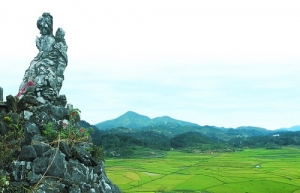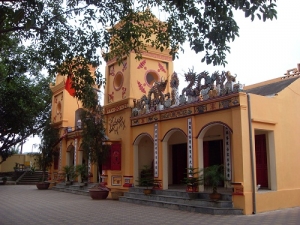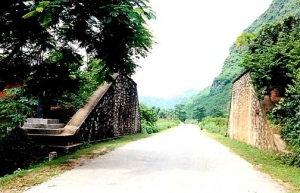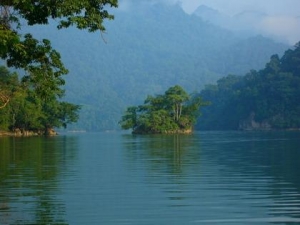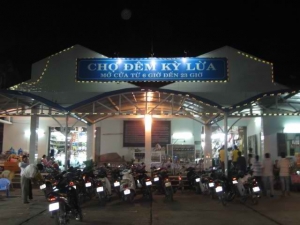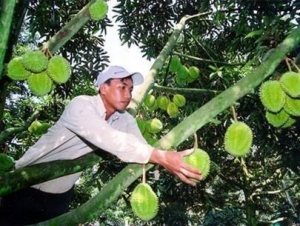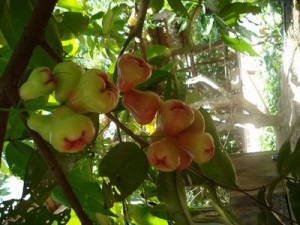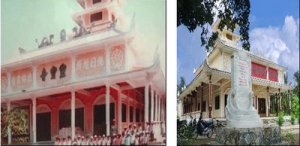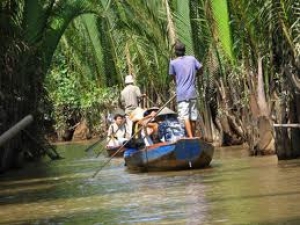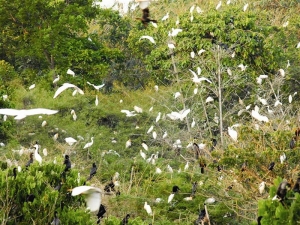
Asia Pacific Travel Team
To Thi Mountain – “Waiting for Her Husband”- Lang Son
To Thi Mountain or Vong Phu Mountain means "waiting for her husband". From ancient times, this human-shaped stone has been associated with the fairy Mrs To Thi hold the baby to waite for husband return from battle field, but never saw him back, and finally she was turned into a rock. So that people called it To Thi.
Located on the Northwest of Tam Thanh Mount, Lang Son City, Lang Son province, the legend about To Thi had come into Vietnamese people mind that has created natural image of a mother hugging her child, waiting for husband so long and they turned into stone. Throughout the years, from natural and human impact, the rock has been heavily damaged. However, Lang Son province has had a copy of To Thi built in order to retain this cherished relic that has gone into the feeling of Vietnamese people.
If possible, you once come to Lang Son in Vietnam travel and visit this mountain where you can see a faithful symbol of the iron hearts of Vietnamese women like Mrs To Thi in the fairy tale.
Ky Cung Temple in Lang Son worships God of River
Ky Cung is still small temple with tiled roof. At the front of temple is a stone wharf Ky Cung( Ky Cung stone way), which was considered as one of 8 Lang Son places of interesting in 18 century by Ngo Thi Si.
The architecture of the temple is the shape of the letter dinh (shape). This is newly-restored architecture. The temple hasn't got its private greeting gate, so greeting gate is matched with main apartment, which includes 3 vault-shaped doors with two brick squars pillars that have got carved edge ways and patters on the surface, there is a set of three holy things: a tripod and two flowers pots. There are two multi-layer towers outside to hang bell and drum.
In 1993, Ky Cung temple was recognized as the National relic by the Ministry of Informationa and Communication.
Today, the temple still remains to be a sacred place and also a tourist attraction In Vietnam travel.
Historical Vestige of Lang Son’s Chi Lang Border
The Chi Lang Border is located in Chi Lang District, Lang Son Province, and 110km from Hanoi and 60km from the Sino-Vietnamese border. It consists of a valley surrounded by high mountains and through which runs the Thuong River.
The mountains were opened in two locations to form two gates. The northern gate was named Quy Mon Quan, meaning "monster gate," after the Chinese invaders who entered Vietnam through this gate. The southern gate was called Ngo The, meaning "swearing gate." Vietnamese ancestors who swore to sacrifice their lives to protect their motherland and to prevent invaders from entering Vietnam via this defile built the gates.
In the past, in this area that King Le Hoan defeated the Chinese Sung troops in 981 and killed all the enemies. In 1076, Prince Consort Than Canh Phuc set a front line against 300,000 Sung enemies. Led by Quach Quy in 1285, Nguyen Dia Lo killed traitor Tran Kien in the second National Resistance against Yuan-Mongol invaders. In 1427, Lam Son righteous army killed invader leader Lieu Thang, caught Hoang Phuc, killed 10,000 Ming enemies and overthrew all their maneuvers.
Nowadays, joining tours in Vietnam, tourists in Vietnam travel considers the Chi Lang Border- a historical vestige as a stop in a journey to Lang Son where they can enjoy the imposingly natural beauty of the landscape.
Best time to travel Ha Giang
During this time, the scenery is magnificent with mountaintops hiding in the cloud and wild peach flowers blooming everywhere. Moreover, the weather during the Tet holidays is very comfortable with little rain and cool air, so that tourists in Vietnam tours do not have to carry raincoats or umbrellas with them.
There are also a lot of unique and attractive festivals to celebrate the New Year during this time. Hence, visitors with Vietnam travel guide can have a chance to know more about the ethnic culture in Ha Giang and enjoy the festive atmosphere of various ethnic groups. Lastly, as this is the dry season and the routes to Ha Giang mostly go along the side of mountains, the roads are much safer for trip.
Ky Lua Market- A Bustling Trade Center of Lang Son
Ky Lua Market in Lang Son is where occurs the exchange of goods between regions in the country with cultural activities being characterized the national identity of Lang Son province. The market monthly occurs 6 sessions dating on 2nd, 7th of lunar calendar, and it consists of goods from almost all provinces.
People usually not only go to market for sale but also to visit, talk about business. Ky Lua Market is also a meeting place of young ethnic people such as Tay, Nung, Dao. They gather in the market, buy the goods, meet their friends and find their partners through love songs. At the market, along with diverse color of brocade, clothes, there are delicious dishes characterized by Lang mountainous area.
Each year, Lang Son occur Ky Lua fair, lasting from 22 to 27 January lunar months, this is the traditional cultural activity. Ky Lua market today has been transformed and open all day and night. With the fresh air of the frontier mountain region, tourists in Vietnam travel can’t help moving and being impressed with the shopping activity in night scenes when once traveling to Lang Son.
Joining tours in Vietnam and you have chance to reach Lang Son, the Ky Lua market will be a worthy-visit place which should not be missed by you!
Cai Mon orchard- The cradle of fruit trees in South Vietnam
Cai Mon is located on the bank of the Tien River in Tien Thuy village, Vinh Thanh commune, Cho Lach District and Ben Tre Province. Cai Mon orchard is considered the cradle of fruit trees in South Vietnam, its small and narrow paths are covered with green trees bearing heavy sweety fruits. Tourists in Vietnam tourism coming there in any seaon can enjoy various fruits around the year.
Cai Mon farming village also provides millions of breeding-tree types such as durian, mangosteen, sweet mango, seedless longan, langsat and varieties of citrus. There are also many graft and multiplication artisans who create the diversity of bonsai shapes by the very spectacular figures of deer, stag, dragon, phoenix, etc. The products are widely sold in Thu Duc, Bien Hoa, and exported to many Asian countries.
To tourists who want to discover the village of South feaure, Cai Mon is an ideal place where they can see and enjoy the fresh fruits despite being in any reason of the year.
Con Qui or Qui islet, the smallest in Ben Tre
Qui Islet, the smallest islet in Ben Tre, is a sandbank with the area of 65 hectares is in Tien Giang river, between 2 communes, Tan Thach and Quoi Son, of Chau Thanh district. There are many orchards such as sapodila, longan, grapefruit, etc. As a new land, so Qui islet is still wild. The violet-white cork flowers is skimming on water surface and swaying lightly in the wind. Green nipas stretch along the river endlessly and flutter on the waves. The cottages loom in the orchards of heavy fruits. The country girls, who are wearing loose-fitting blouses, drive motor boats or strongly paddle their fruits to market.

Paddle fruits to the market
When sitting in windy spacious houses, the floating pavilions, the Coconut region tourist restaurants, tourists in Vietnam tourism can relax their eyes from water hyacinth in poetic purple flowers. The restaurants are made of bamboo, nipa leaves furnished modernly and the visitors can enjoy the popular special dishes here such as sour soup with pangasius krempfi, cork and spinach; red african carp steamed with termite castings and pumpkin flowers; anabas or pseudapocryptes elongatus or snakehead fish cooked in fish sauce on bowl. While listening to the harmonious sound of amateur folk music and songs, tourist joining tours in Vietnam can enjoy fresh fruits and sip a cup of honey tea (the homemade product). The amateur folk music and song has existed for a long time in Ben Tre and more and more developed, which makes the rivery region more graceful.
Listening to amateur folk music in windy spacious houses- Qui islet- Ben Tre
Having exsited for a long time in Ben Tre, the amateur folk music and songs have been more and more developed, which makes the rivery region more graceful and attracts more tourists to the region.
Tuyen Linh Pagoda in Recognition of Nation as Cultural and Historical Heritage
It was built in Tan Rooster (1861), the reign of Tu Duc in the 14th. Firstly, Tuyen Linh pagoda named Tien Phong Khanh Linh by the venerable abbot, and is made of bamboo and leaves Sam to her church.
In 1907, the Le Khanh Hoa, legal name is Thich Nhu Tri, in Phu Le Commune; Ba Tri district, wh has become the guardian of this temple. He is a very respectful Buddhist master; a venerable scholar Le Khanh Hoa has preached the Buddhist doctrine, training students. With a lot of knowledge, he makes more than 90% of local people following Buddhism which made by the venerable Le Khanh Hoa the founder of the Southern Buddhist and Luong Xuyen Buddhist associations.
Nguyen Sinh Sac, Uncle Ho's father had several dozen remained excluded in Tuyen Linh pagoda. He has been here for a very long time, from 1927 to 1929. During his stay at the temple, he set up teaching classes, medicine room to cure for people. This is also the place where Mr Nguyen Sinh Sac had met Tran Van An, Huynh Khac Man, Le Van Phat, and the number of people they later became first class members of the Party Committee of Ben Tre. In 1929, he was being sick and people found the way taking him to Dong Thap. Tuyen Linh pagoda is also the place where a lot of Vietnamese soldiers have been hidden. It was twice destroyed by boom of enemy. The pagoda has been restored several times and the latest renovation was in 1999. However, many historical objects have been lost. The chairman of Minh Duc commune Viet Hung said they were planning to build the museum in that pagoda. Firstly, they would collect the ancient objects, restore the pagoda and after that they would reconstruct the transportation system for visitors in Vietnam tourism easily traveling to Tuyen Linh Pagoda.
Thanks to the recognition of the nation as cultural and historical heritage site, Tuyen Linh pagoda of Ben Tre province surely will attract more and more travelers, making great contributions to the development of the regional tourism.
Holy Land of Coconut Religion in Ben Tre- Phung Islet
Phung Islet thas another name that is Tan Vinh islet, which is an island floating on Tien River in Tan Thach commune, Chau Thanh suburban district. It is just only 12km far from the center of Ben Tre. Phung islet is famous not only for its variety of fruits, especially the coconuts, but also for the delicious dishes of south-east Vietnam. Visitors in Vietnam tourism can reach the islet by boat.
Visitors in Vietnam tourism can reach this islet by boat. After taking time on the islet, visitors can continue to ride along the river, visiting the handicraft and coconut factories, and then disembark to catch a coach ride to tropical gardens. Here they can rest under shadow of coconut trees, sip tea with fresh honey and blueberries while listening to the beautiful melodies of traditional music.
Coming to Phung islet tourist area, tourists joining tours in Vietnam will do sightseeing unique architectural projects of the place where used to be the holy land of Coconut religion, which once spread over 1,500 km2 of Ben Tre. The Coconut Religion was created in the 1940s by Nguyen Thanh Nam. The name "Phung islet" existed when Mr. Nam came here and built Nam Quoc Phat pagoda. When this work was being built, they found out an ancient bowl carved with a phoenix, since then, they called it Phung islet.
Another special point about Phung Islet is about the daily life. The residents living here focus on making handicrafts from the coconut trees. Visitors in Vietnam travel coming here can witness the process of making coconut candies and other souvenirs, and pick something to take home as a present. If tourists feel hungry, they can eat with local residents who will serve their everyday meal of simple but delicious foods. Weary travelers can also have a nap under the shadow of garden trees, or take path in exciting activities like photographing ostriches or crocodile fishing.
Now, Phung Islet tourist area has a room of amateur folk music specializing in serving tourists. This room is put in a man-made stone cave with a lot of stalactites which make the air inside the cave very cool. Coming here, tourists in Vietnam travel will be served with smooth and profound Southern folk songs.
Ben Tre Viet Nam is famous for Vam Ho Bird Sanctuary
Vam Ho Bird Sanctuary which is 52 km from Ben Tre town or 120 km from Ho Chi Minh city lies in the area of two communes My Hoa and Tan Xuan, Ba Tri District, near Ba Lai Estuary.
Vam Ho gathers many wild forests with a great variety of trees including water coconut, mangrove, and reed, etc. Vam Ho has long become a favorite destination for many animals, especially birds, to which the region is dedicated. There are about 84 species of birds in 35 classes, including 500,000 storks. Vam Ho Bird Sanctuary is home to thousands of storks, herons and other types of birds. The best time to see the storks is from April to October, as this is time when they take refuge in Vam Ho garden to produce and raise their young.
At 4pm to 5pm everyday, an interesting event takes place. Thousands of storks coming home nearly whiten all the tree tops. Meanwhile, the herons begin their night searching for food. Besides white storks, visitors in Vietnam tourism can see many other types of storks as well as bats, snakes, weasels and pythons. They may also find themselves get lost in the world of birds, with various shapes and sounds. The sound of thousands of birds mixing and playing, dancing and whooping becomes the enchanting song of the jungle. In addition, the song of the storks has different rhythms and calls of other wild birds mixed with the sound of leaves, which makes a silent summer’s night shimmer with excitement.
 Tourists in Vietnam tourism travel to Vam Ho by boat.
Tourists in Vietnam tourism travel to Vam Ho by boat.
Visiting Vam Ho Bird Sanctuary, tourists participating in tours in Vietnam have an opportunity to travel around by boat, penetrate the submerged forest and step along narrow bamboo bridges to fill their chests with the fresh air of a well-preserved wetland. Especially, travelers can take a rest under the shadow of the forest or visit relics of American resistance war in Vietnam.


